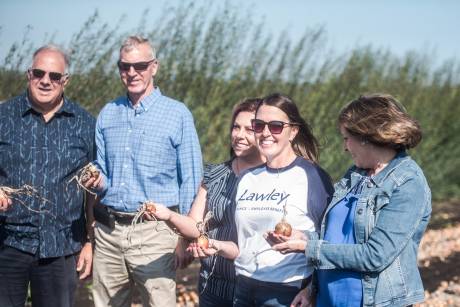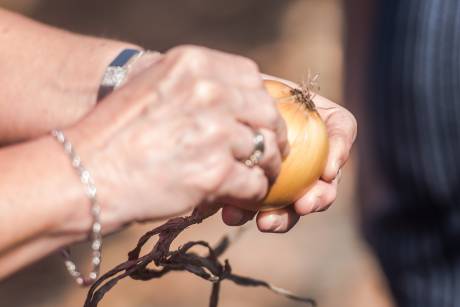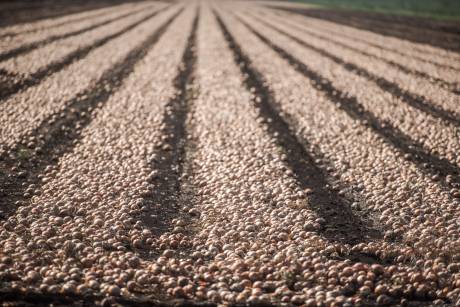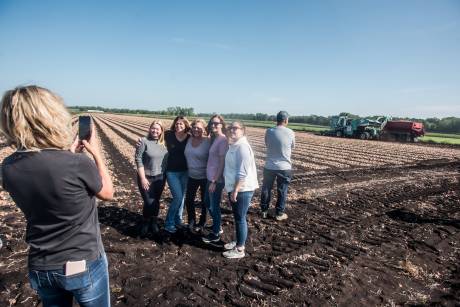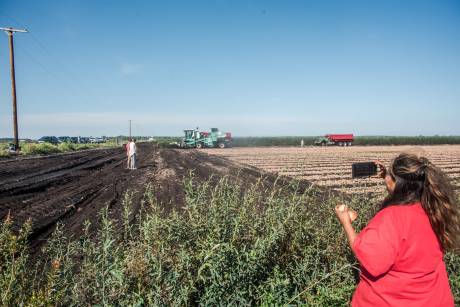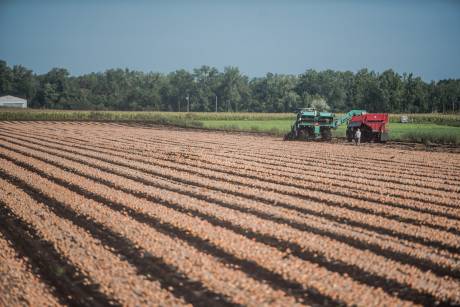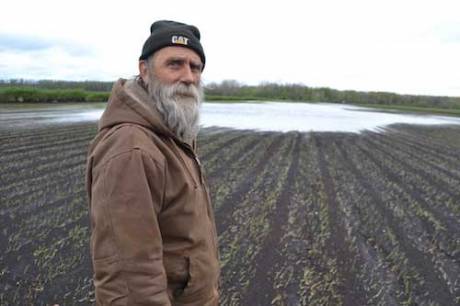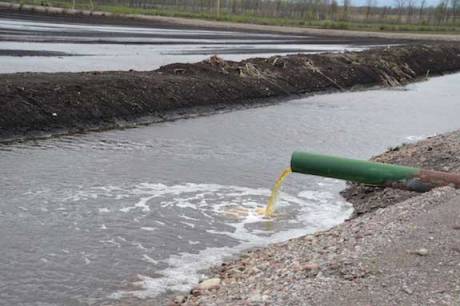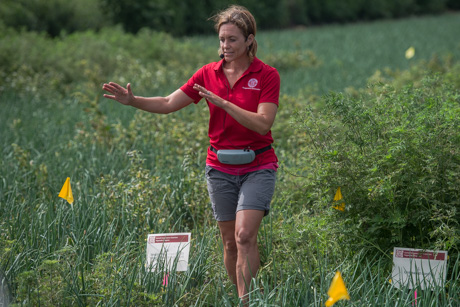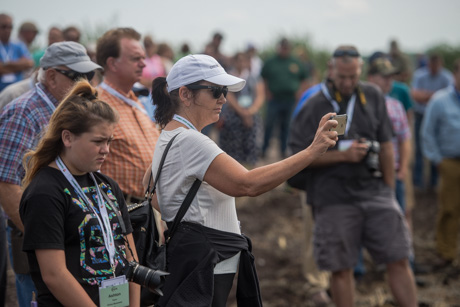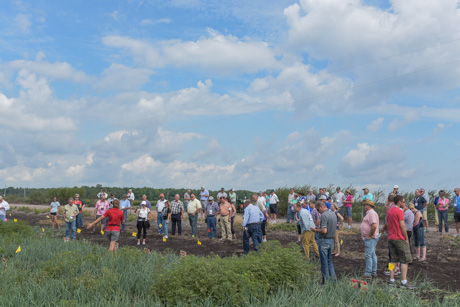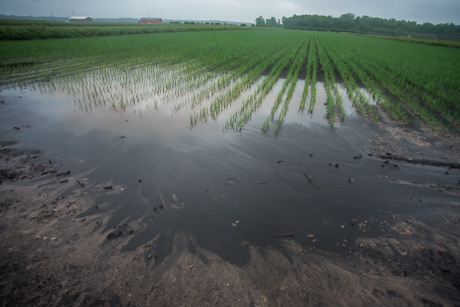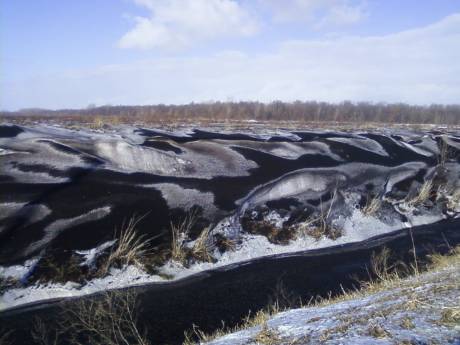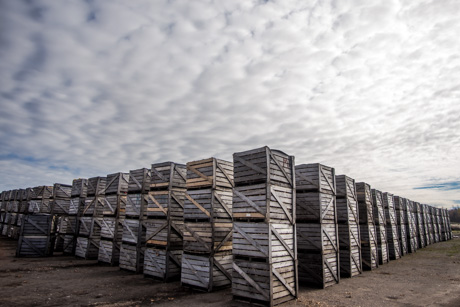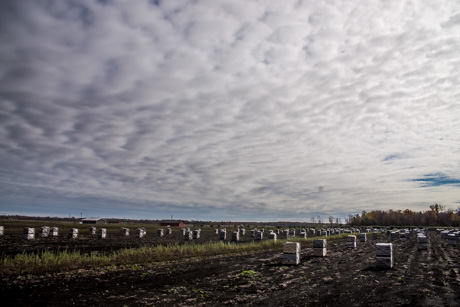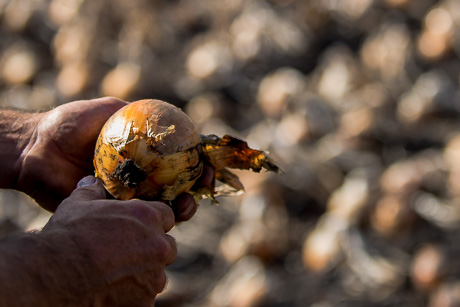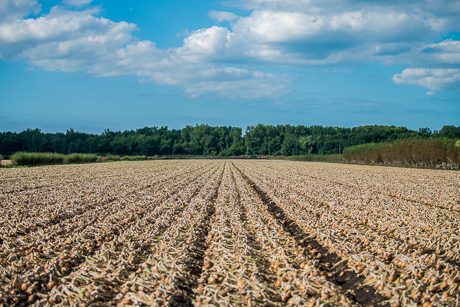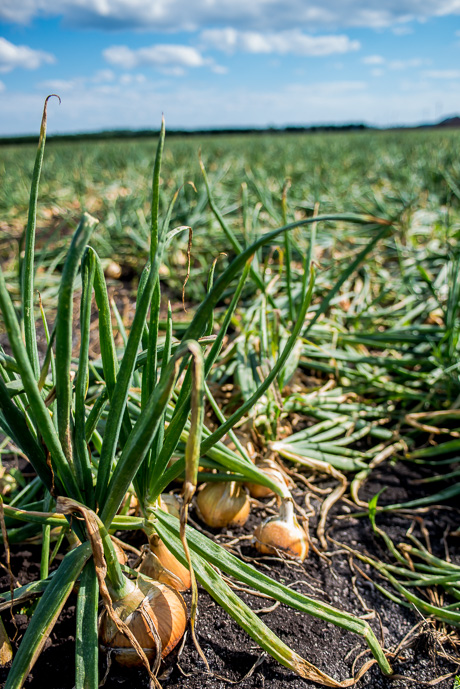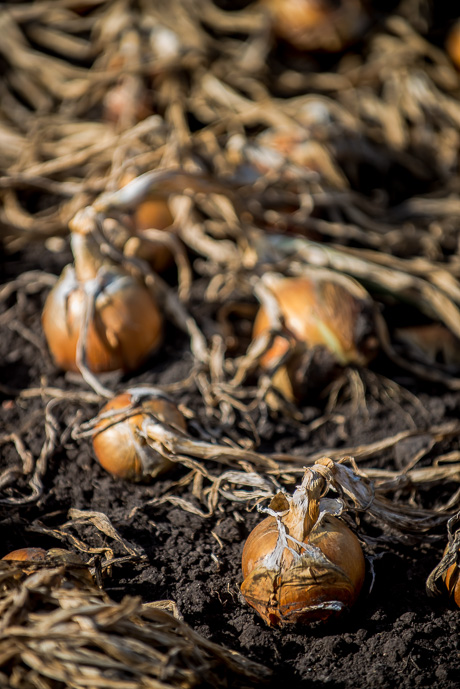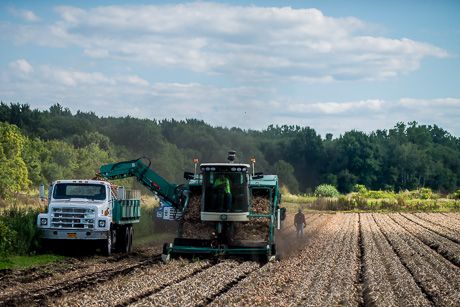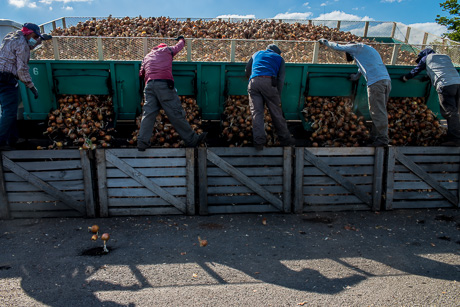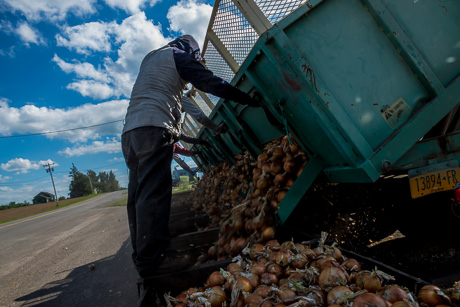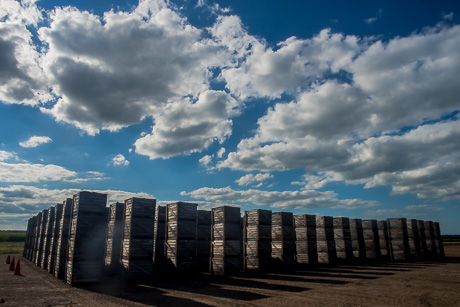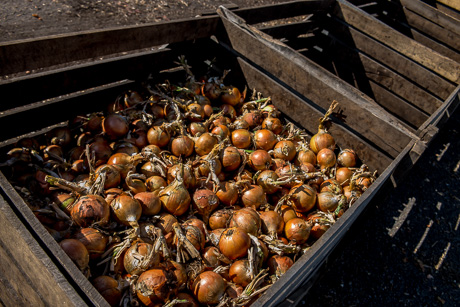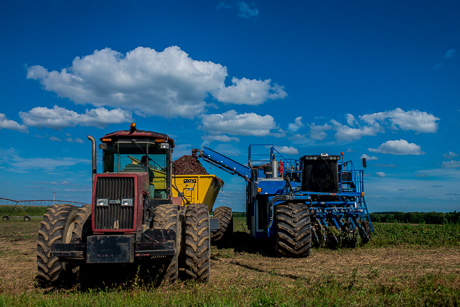This is the second in a series of profiles of Genesee County's farms and farmers.
Working the muck has never been easy.
When third-generation muck farmer Joe Bezon was a boy, he would work alongside his mother, each on their hands and knees, pulling weeds.
Seeds were planted by hand and it took manual labor to bring in the crop. When muck is wet, it's deep and muddy ground. When it's dry, the fine dust gets in your eyes and nose and the sun's rays radiate heat off the black soil.
Today, machinery and chemicals make sowing, harvesting and weeding easier, but no machine can control Mother Nature, or the government.
Winds damage crops and workers are harder to find as the Immigration and Naturalization Service (INS) rounds up all the farm labor.
Still, Bezon, in his 75th year, toils on, and is quite happy doing it.
"I enjoy it and I got this (highland in Byron, where we were standing talking) and that (muckland in Orleans County) down there and I've got a son who helps me all the time," Bezon said. "If I had to do it all myself, it would be a different story."
Today, Bezon & Sons Farm is 383 acres, with 110 acres of muckland, and is run by Joe, his wife Edith, son Joey and son-in-law Jim.
The Bezons, along with the Mortellaros and the Halats, are the last of the original muckland farmers in Genesee County.
Before the 1950s, there were as many as 160 families working the muck, each with plots of three to 10 acres of land.
As machinery was invented to make farming muck easier, and more and more farmers figured there has got to be an easier way to make a living, the families of the muck thinned out.
The Bezons were among the first to start consolidating their holdings.
Joey Bezon, who like his father has been working the muck his whole life, is perhaps the last Bezon who will farm the muck, unless his son, who now works for CY Farms, decides to work the Bezon land some day.
"I have a little bit of pride in it because we're one of the only ones who stuck with it," Joey said. "There was something like 160 some 40 or 50 years ago and everybody just kind of threw in the towel except for only a handful who are left and could stay with it. We used to be big or medium size and now we're one of the smallest ones. How long we can stay in the game with everybody else getting bigger, that's the challenge."
Muckland is reclaimed swampland. Over hundreds of years, trees and vegetation rotted in standing water to create a rich black soil that is full of tiny wood chips, making it both porous and a good medium for retaining moisture. It's about 80 percent organic matter.
Early muckers grew carrots, lettuce, spinach, potatoes and onions. Today, onions are the big muck crop locally, with some potatoes, and some of the more played-out muck west of Route 98 is used to grow turf.
Onions need deep, loose well-drained soil that retains moisture. There's big onion production in the desert soil of California, but the black muck of Genesee and Orleans counties has more organic matter and retains moisture better.
"Muck is special because unlike sandy soils or clay soils, the roots grow aggressively in it and they get enough moisture to form the onion," said Paul Mortellaro who has also been working mucklands his entire life with his family.
We call it the Elba Muck, but a majority of the 6,000 acres of muck still being farmed is in Orleans County. There's a lot in Byron, and just a corner of the southwest part of the fields are in Elba.
Elba may host the Onion Festival, but there hasn't been an onion grown in Elba for years, as far as anybody knows.
There was once more farmable muck in Elba, but to be useful, the mucklands need to be several feet deep. Much of the muck farms in Elba have been lost to oxidation and wind. What little of it left is used to grown corn and turf.
The local muckland was once part of the Alabama Swamp, which once covered 25,000 acres.
After the turn of the 20th Century, local residents were increasingly concerned about odor, mosquitoes and disease associated with the swamplands in Elba and Byron. (source for historical background)
Perhaps the entire Alabama Swamp would have been drained at the time, but much of the area has rocks and stone much closer to the surface than the Elba Muck. To be tillable, muck must be several feet deep.
And even to this day, farmers still pull out rotting tree stumps that work their way to the surface of the muck every spring.
It took the invention of the steam shovel to make draining the swamps possible.
Western New York Farms Company, based in New York City, owned 9,000 acres of muckland, and at the urging of state officials, drainage work started in 1913. By 1914, there were eight miles of canals 20 feet deep in place and lumberjacks started removing trees.
Farming started in 1915.
While muck farming was immediately successful, Farms Co. always intended to lease the land to tenant farmers, and the first leases were signed in 1916. The first year, Farms Co. leased land for $50 an acre and made machinery and assistance available to farmers. The next year, prices dropped to $35 an acre, but no more help came from Farms Co.
In 1927, Farms Co. decided to sell off its land, offering plots on favorable terms to farmers.
Edith Bezon isn't sure when Joe's father and mother first bought into the mucklands. It was before 1936.
The elder Bezon was the son of a muck farmer 17 miles to the west. Joe Bezon said when his grandfather died he had a chance to take over that farm, but he couldn't see farming Elba Muck and muck 17 miles away.
The Bezon's started out with a couple of 10-acre plots that they worked by hand.
When Joe's mother was weeding, she used onion crates as cribs for her boys.
"I can picture that," Joe said. "I can take you down where the shade was. There was a lean-to. They'd put us in a crate and put another one on top of it. There was a ditch right along the muck. I filled it all in and put tile in it. She would put us in the lean-to and she'd take straps and tie two crates together and set us there."
It was the only way to keep the rambunctious boys safe while she worked.
"We would say we wouldn't, don't worry we won't, we won't go out there," Joe said. "But as soon as they got down to the second plot and they'd have their backs to us, we'd run down the road with a wheelbarrow that they carried the weeds with. We would run up and down the road with it. Of course, in those days, there was traffic going, but heck, today, there's no traffic down there."
As time went on, Joe's father diversified his holdings. He bought other land, including ranch land on Oak Orchard Road in Elba where he started raising Angus. Today, that land is a dairy farm owned by Joe's younger brother, Eugene.
Joe's older brother left the muck for good when he went off to fight in World War II.
When he returned, he helped his father run his two motels -- the Sunset Motel on West Main Street Road, Batavia, and the Park Oak Motel, once just off Route 98 and the Thruway exit in Batavia.
Joe and Edith grew up together. Both went to Elba Central School.
When they were first married, they had a place on Pekin Road, but in 1966 bought a farm and farmhouse on Searls Road, Byron.
There they raised their two sons -- Joey and Rick -- and two daughters -- Laurie and Amanda.
Laurie now lives just down the road. She married Jim, who works with Bezon & Sons and Amanda went to work in pharmaceuticals and lives in Philadelphia.
"She enjoys the city life," Edith said. "She always said, 'I only showed 4-H because my dad made me.' "
Rick works at Genesee Community College.
Joe and Edith have five grandchildren.
"The family is growing, but I don't know about being farmers," Edith said.
"We don't have any of the grandchildren working here because it's such a hard life and most years there isn't a lot of money in it," Edith said. "The past few years, we've been doing good, but in 2010, we had no crop at all on the muck. We got flooded out and it was so late, we couldn't put seed in. We had to go to crop insurance, but that's the first time we ever had to do it."
Besides onions on the muck -- the only crop the Bezons have ever grown on the muck -- the family grows on its upland farm cabbage, corn and soy beans.
For years, the Bezons would put in 20 acres of cabbage, which can be a pretty lucrative crop in good years, but the short supply of farm labor has them cutting back to 12 acres this year.
"It's all gone back to the family doing all of the work," Edith said. "I wish they would come up with a program for us where we could hire workers and not worry about the INS coming in and getting them all."
She said when there are immigration raids, officials round up all the workers -- here legally or not -- and take all of them back to Batavia to sort out, which is a major disruption the farm work.
On the farm, Joe also raises beef cattle. Edith calls it his hobby. Joe says it's the favorite part of farming.
All of the Bezon cattle is slaughtered and butchered right on the farm by Joey. The meat is sold to local residents -- the ones who pay their bills, Joe said.
By this time of year, the Bezons have finished planting their onion seeds.
While the Torreys and some other muck farms plant seedlings, the Bezons prefer seeds.
Onion seeds are very, very tiny. They are rolled in clay, which helps make it easier to plant the seeds using machines.
Rows of barley are planted between the rows of onions to help prevent wind erosion of the muck and protect the tender baby onion leaves from wind damage.
There are little wood chips in the muck that can tear an onion leaf to shreds.
"The wind moves those little chips around like buzz saws and they will cut the tops right off," Edith said.
In the early part of the growing season, onions are in a precarious state. Paul Mortellaro said it isn't unusual to lose one in four acres of new plants to wind.
The Mortellaros typically plant seedlings, but whether seedlings or seeds, when you account for the plants, the fertilizer, the labor, the land costs, taxes and the water, expenses for an acre of onions is from $2,500 to $5,000.
The good years -- which don't happen often, Mortellaro said -- can generate about $12,000 per acre in revenue.
Some years, there's no profit, and perhaps even a loss on the onion fields of the mucklands.
The muck is like its own little microclimate, Mortellaro said. The black soil radiates the heat and makes the flatlands much like a desert in the midst of lush Western New York.
"I've seen it," Mortellaro said, "since the time I was 10 out there weeding -- clouds coming in from Buffalo and they totally disappear by the time they get to the Elba Muck. My brother and I used to speculate that there was a column of warm air rising up from the muck. It is a mini desert during the summertime. It can be really really dry."
If you have good eyes, on a dry, windy day, you can see spirals of dust rising 500 feet into the air, looking like a tornado, Mortellaro said.
The Torreys have added their own above-ground, automated irrigation system to their muck property, but the Bezons largely irrigate by hand.
There were years, Edith said, when she and Joe would sleep in their truck all night, waking at regular intervals to move the irrigation lines.
The Bezons put down about a ton of nitrogen fertilizer per acre of muck, Edith said.
You might think muck, being such an organically rich soil, wouldn't need fertilizer, but new plants in the spring need a lot of nitrogen to get started. After that, the wonders of the muck do the job, but the nitrogen once trapped by the swamp was long ago depleted.
"When they first broke up the muck, all this compost was giving up its nitrogen and it got to the point where it was all leached out," Mortellaro said. "After about five years, you couldn't grow a decent crop without putting those inputs into the muck, so going back as far as anybody can remember, you've had to put in quite a bit of fertilizer."
The onion harvest for the Bezons will be in late August or early September. Edith helps drive the harvest truck when the time comes.
The onions are first pulled out of the ground and left to sit in the sun for three days. The tops need to dry so they will fall off and not get caught up in the machinery. Without that proper topping off, the onions are more susceptible to disease.
If there isn't three days of warm sun, it jeopardizes the harvest.
The onions are scooped up by a self-propelled onion harvester that was invented and built in Elba by Lee Shuknecht and Sons.
Throughout the growing season, the Bezons battle two of nature's persistent elements: Wind and weeds.
To Joe, some of his neighbors aren't very good muckers. They let weeds grow around their plots and don't do a very good job of maintaining their hedgerows.
Hedges, only about four-feet tall, separate plots in the mucklands. They act as wind breaks and catch some of the muck that might otherwise blow away.
Edith estimates that wind carries away about an inch of muck a year. She figures by the time her grandson is ready to retire -- if he becomes a mucker -- there won't be any muck left to farm.
It's not just wind, but also oxidation that depletes the muck, Mortellaro said.
The little particles of wood that make up muck dry out in the summer heat or during a winter drought just like old barn wood, Mortellaro said.
Even with wind and oxidation, Mortellaro isn't sure the muck is declining at the rate of an inch a year -- the process probably isn't that linear, but certainly, a lot of muck has disappeared over the past 90 years.
He's excavated enough around the the gravel roadways -- built on top of muck -- to see what the original level of the muck used to be, he said. He estimates that areas that were once 12-feet deep in muck are now nine-feet deep.
"It is discouraging," Mortelloro said. "You see the gravel road out there. The road doesn't go away and the fields keep getting lower."
The Bezons own 110 acres of muckland, but only 98 acres are tillable. There are swaths of former muckland that are now just rocks.
As for weeds, Joe is obsessive about weeds, Edith said.
You don't get good onions when weeds are growing in the fields, Joe said. Onions don't do well when competing for nutrients. At harvest, the weeds get all tangled up in the machinery and have to be picked out during grading.
"Joe has always really taken care of the land, because that's what he lives for, being down there mucking," Edith said. "He's been down there since he was born."
It used to be that weeds had to be removed by hand and carried off in bags or buckets. Now Joe uses mostly chemicals, he said.
"Weeding is not like it used to be," Joe said. "You were out there on your hands and knees. I've got pictures of my mother out on her hands and knees weeding in the muck. We didn't have chemicals in those days. Now, heck, you can put it out there and keep it clean."
Sure there are some hardships with farming muck, Joe said, but it's nothing like the old days. The worst part of machine farming is maintaining the equipment. When it breaks, it is a lot more expensive to fix.
So long as he's got help, though, Joe said he can handle the work.
All the machinery in the world can't change the weather or the wind or the nature of muck, Edith said.
"You've always got to be one step ahead of Mother Nature," Edith said. "Out here, some days, she can be very cruel."
Joe and Edith on one of their upland plots. Joe was plowing that day, preparing the field for planting.
Joey Bezon in a field that will soon be growing corn. The tractor is a loaner because one of the Bezon's tractors was in the shop being repaired. As farm machinery has gotten more complex, it's more expensive to fix and harder for the farmer to do it himself.
Muck -- sifted a bit by the wind so that the wood chips are a little more visible.
Onions and barley growing in a muck field. If you look at the picture in the slide show below at full-screen resolution, the little onion sprouts will be easier to see. In the distance, rocks that were once buried by muck. Wind and oxidation are reducing the amount of muck in the mucklands every year.

